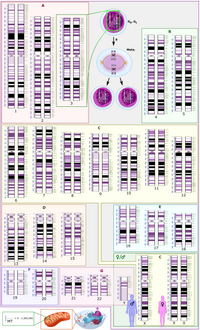
Photo from wikipedia
Significance Here we use the expression and accessibility data from a diverse set of cell types to learn a model for the dependence of the accessibility of a regulatory element… Click to show full abstract
Significance Here we use the expression and accessibility data from a diverse set of cell types to learn a model for the dependence of the accessibility of a regulatory element on its DNA sequence and TF expression. Using GTEx samples with WGS data, we show that the noncoding variants predicted to affect accessibility are more strongly associated with the expression of nearby genes. To interpret a personal genome, we combine the sequence information with context-specific TF expression to prioritize variants and regulatory elements in any genomic region of interest. This approach should be helpful in the study of risk loci previously identified by GWAS. Results from analysis of height and WGS data from the GTEx project support this hypothesis. A person’s genome typically contains millions of variants which represent the differences between this personal genome and the reference human genome. The interpretation of these variants, i.e., the assessment of their potential impact on a person’s phenotype, is currently of great interest in human genetics and medicine. We have developed a prioritization tool called OpenCausal which takes as inputs 1) a personal genome and 2) a reference context-specific TF expression profile and returns a list of noncoding variants prioritized according to their impact on chromatin accessibility for any given genomic region of interest. We applied OpenCausal to 6,430 samples across 18 tissues derived from the GTEx project and found that the variants prioritized by OpenCausal are highly enriched for eQTLs and caQTLs. We further propose a strategy to integrate the predicted open scores with genome-wide association studies (GWAS) data to prioritize putative causal variants and regulatory elements for a given risk locus (i.e., fine-mapping analysis). As an initial example, we applied this method to a GWAS dataset of human height and found that the prioritized putative variants and elements are correlated with the phenotype (i.e., heights of individuals) better than others.
Journal Title: Proceedings of the National Academy of Sciences of the United States of America
Year Published: 2020
Link to full text (if available)
Share on Social Media: Sign Up to like & get
recommendations!